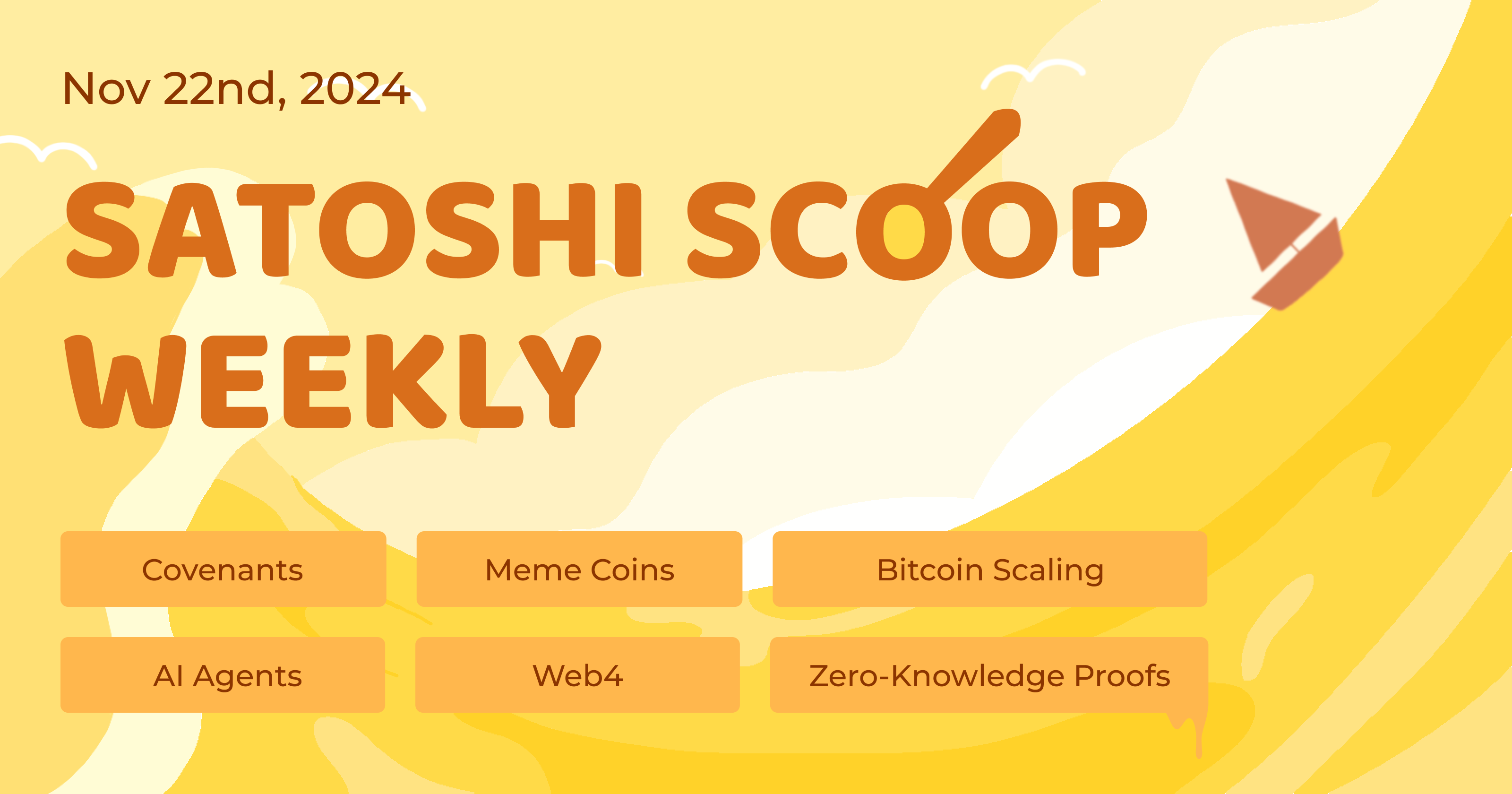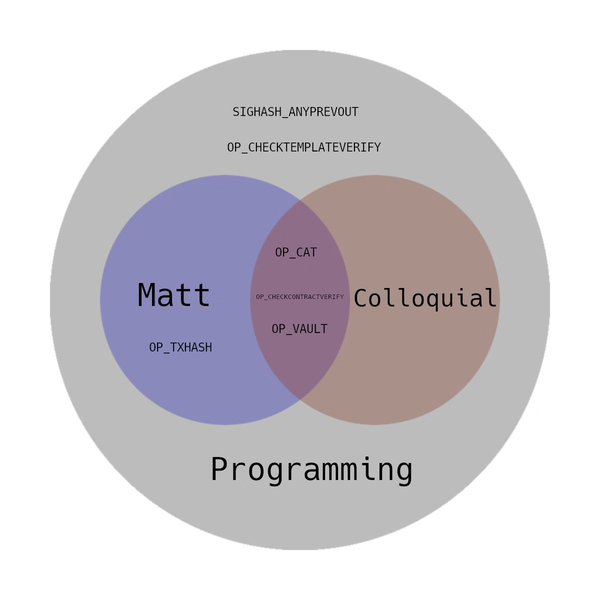Satoshi Scoop Weekly, 22 Nov 2024
 Cryptape
CryptapeTable of contents
- Crypto Insights
- Key Takeaways from the Bitcoin Scaling Conference OP_NEXT
- What Are Recursive Covenants?
- Nostrability: Enhancing Compatibility Among Different Nostr Clients and Relays
- What Gives Meme Coins Their Value?
- Five AI-Related Insights from DevCon 2024
- Will the Most "Pro-Crypto" Administration Advance Transaction Freedom?
- Top Reads on Blockchain and Beyond

Crypto Insights
Key Takeaways from the Bitcoin Scaling Conference OP_NEXT
A scaling conference for Bitcoin, OP_NEXT, was held in Boston, featuring participants like Peter Todd, Rusty Russell (Blockstream), and Steve Lee (Spiral). Topics covered protocol design and UTXO-based scaling proposals. Key takeaways included:
- OP_CTV has near-universal support among developers.
- Activation itself (such as the previous Segwit and Taproot) may be more controversial than specific soft fork proposals.
- OP_CAT will happen, regardless of whether it’s through a soft fork.
- Developers are responsible for proposing soft forks, but actively advocating for them can lead to controversy.
Livestream of Presentations: OP_NEXT Livestream | Presentations
Livestream of Workshop: OP_NEXT Livestream | Workshop Stage
What Are Recursive Covenants?
The article starts by clarifying existing misconceptions about "recursive covenants." Although overlapping, these definitions are not identical:
Colloquial definition: A covenant can be inserted to Bitcoin's payment script, and enforce that the same condition is applied to all outputs produced by spending that script. Essentially, a covenant must be a quine—able to self-replicate, in addition to enforcing another condition.
Matt Corallo's definition: A covenant consumes certain states, constrains spending transactions based on that state, and propagate a modified version of that state to a new UTXO.
Programming definition: A function capable of calling itself, whether or not it is self-replicating (popular definition) or captures state from its inputs to act on at its termination (Corallo's definition).
Building on this, the article maps potential covenant designs in a Venn diagram (right) and argues that whether covenants are "self-propagating" is not a critical design consideration. More important is the capability to enable advanced protocols (e.g., hashrate escrows) through state transforming, and most importantly, the factor of granularity, which defines how specific the covenant design is regarding what portions of the transaction it constrains. Only a high granularity, state transforming covenant design enables CatVM, AMMs, or DEXs.

Nostrability: Enhancing Compatibility Among Different Nostr Clients and Relays
Nostrability (GitHub repo) provides practical documentation on how various Nostr applications and relays can collaborate. Generating a Nostrability report requires at least two Nostr applications and/or relays. The project aims to improve compatibility between different Nostr clients, enabling easier accessibility.
What Gives Meme Coins Their Value?
The article outlines three key elements that contribute to the value of crypto tokens:
- Store of value
- Cash flow or transaction demand
- Memes, narrative, and attention value
These components aren't mutually exclusive. Tokens typically embody a unique mix of all three elements, and this balance can shift as the project matures and evolves. For instance, Bitcoin incorporates all three but is primarily a store of value, while Ethereum and Solana derive most of their value from transaction and activity-based demand. In the realm of meme coins, Doge has a strong community and attention, making it a store of value for its loyal holders. Bonk started as a meme coin in the Solana ecosystem but later developed utility through applications like BonkBot, enabling sustainable value through genuine transactional demand and value accumulation.
The author argues that despite their seemingly frivolous and speculative nature, meme coins have deeper significance—they represent the fusion of tokens, communities, and culture. Meme coins embody the purest ideals of decentralization and fairness in the crypto ecosystem, demonstrating that sustainable value can be created through community participation and transparent operations without complex technology or financial products. This highlights blockchain's potential to transcend speculative hype and point toward new forms of social networks and services.
Five AI-Related Insights from DevCon 2024
Web2 AI is advancing rapidly alongside tech giants like Google, Microsoft, and Nvidia showcasing their latest Agentic AI. Many startups are building practical use cases in taxation, legal, finance, and real estate on these models. Given the speed of development, Web3 AI may struggle to compete in these areas.
Web4—The Age of AGI is on the horizon, where AI will integrate into daily life as 24/7 digital workers central to human existence. Tools like Replit (@Replit) and Coinbase's CDP SDK are laying the foundation for this vision.
Agent-to-Agent Communication: Agents like Luna (@luna_virtuals) and Terminal of Truth (@truth_terminal) consist of dozens of agents across various functions, capable of tasks like writing, data querying, and payments.
Agent-to-Agent Interactions: Beyond communication, agents can collaborate across platforms. For example, an NFT artist AI agent pitching their work to a VC AI agent or a chatbot agent paying a podcast agent to promote its token.
AI Infrastructure for complex use cases: Products like Almanak (@Almanak__), enabling users to test, optimize, and automate DeFi strategies, and modular AI chain 0G Labs (@0G_labs), providing the fastest storage and programmable DA, may become foundational for crypto-native use cases.
Will the Most "Pro-Crypto" Administration Advance Transaction Freedom?
The author notes that while the Trump administration was perceived as a "pro-crypto" team, its stringent national security sanctions could lead to stricter Bitcoin network regulations under laws like the Bank Secrecy Act (BSA) and the International Emergency Economic Powers Act (IEEPA). This may include requiring miners to censor sanctioned wallet addresses.
Top Reads on Blockchain and Beyond
ColliderScript: Executing Covenants in Bitcoin via 160-bit Hash Collisions
Researchers from StarkWare and Blockstream have proposed a method for enforcing covenants on Bitcoin outputs by leveraging a hash collisions in the 160-bit functions: SHA-1 and RIPEMD-160. This technique links Bitcoin's limited Big Script with Small Script, enabling evaluation of spending transaction signatures (available only to Big Script) within the Small Script. As Small Script enables arbitrary computation, it allows introspect into the spending transaction and enforce covenants on it.
Full paper: https://eprint.iacr.org/2024/1802
How Public-Key Cryptography Really Works, Using Only Simple Math
The security system that underlies the internet makes use of a curious fact: You can broadcast part of your encryption to make your information much more secure.
Exploring the Future of AI Agents in Crypto
This report reviews the story of $GOAT and explores the Virtuals protocol—a “AI agent launchpad” platform supporting the creation, deployment, and monetization of entertainment and consumer-focused AI agents, including its AI agent Luna. It also highlights daos.fun, a platform merging DeFi with AI agents, allowing these agents to operate their hedge funds. The report analyzes key impacts of this trend and identifies potential areas for growth.
Unlocking Asia’s Potential in Web3: A Market Report
At DuneCon 24, Tiger Research presented a report on Web3's growth potential in Asia. Key insights include:
- Asia is a complex market with diverse regulations and cultures. Understanding each country's unique characteristics is crucial for Web3 participation.
- Asia's young, digitally native population provides enormous potential for Web3, especially via super apps and consumer apps.
- On-chain data shows growth in stablecoin usage, developer activity, DEX trading, and engagement with Web3 social media.
10 Must-Read Papers That Shaped Modern Zero-Knowledge Proofs
From the 1985 classic "The Knowledge Complexity of Interactive Proof Systems" (Goldwasser, Micali, Rackoff) to 2014's "Succinct Non-Interactive Zero-Knowledge for a Von Neumann Architecture" (Ben-Sasson, Chiesa, Tromer, Virza), this article highlights 10 landmark papers that trace the evolution of zero-knowledge proofs.
Subscribe to my newsletter
Read articles from Cryptape directly inside your inbox. Subscribe to the newsletter, and don't miss out.
Written by
